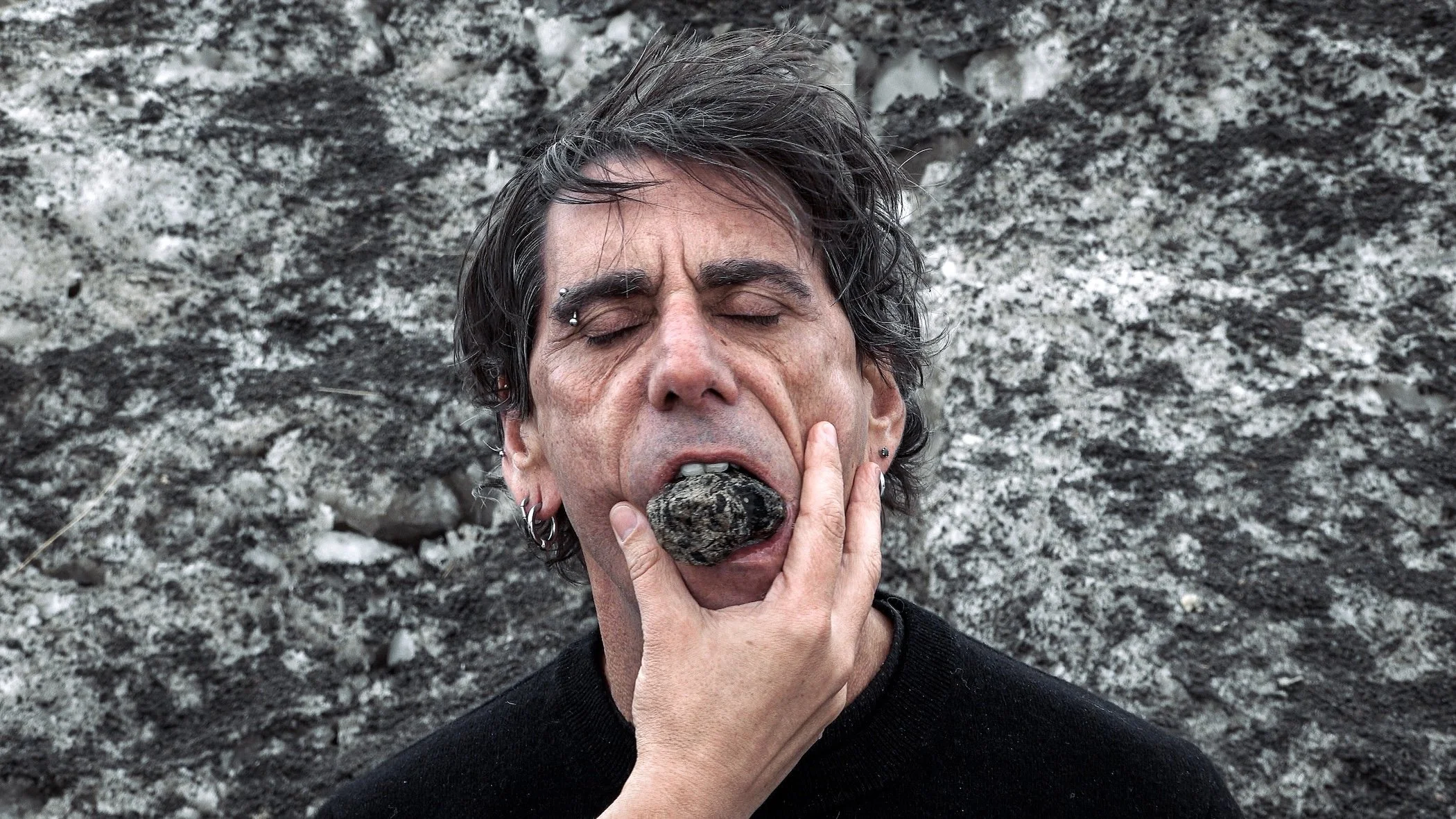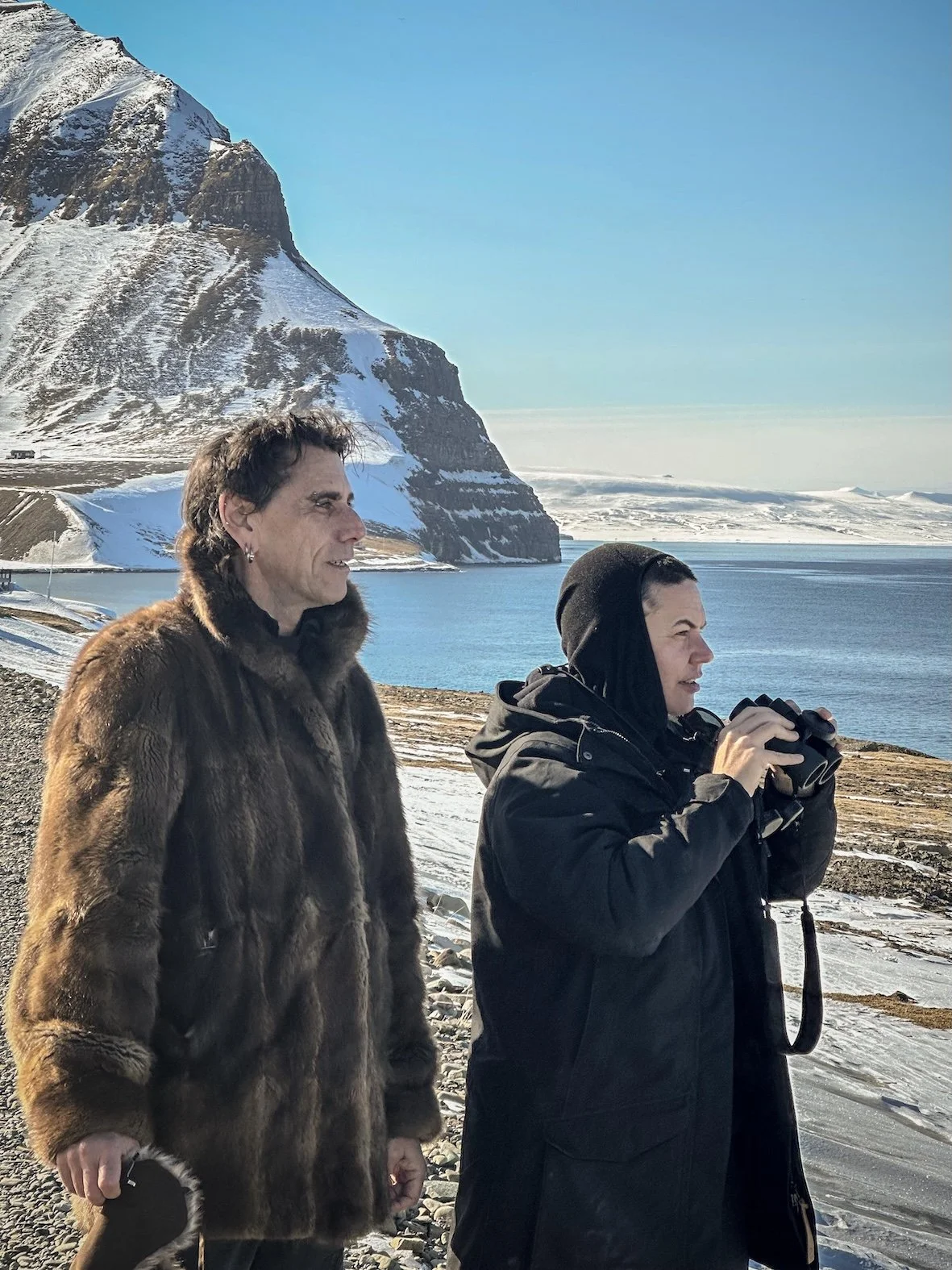A Logbook from A Desert of North by VestAndPage
Still from Deserts Black and Blue, Performance for video with Adventdalen, 2025 © VestAndPage.
VERENA
I learn new ways of making kin here (in each valley one): Make kin with the light. Make kin with fluid time and unstable grounds. Make kin with ambipolar electric, magnetic, and gravitational fields, conduction and friction. Be full of electrical charge – never fully uncharging.
I move from “doing” into “being”: three weeks of sitting and sleeping under the town's avalanche protection are the epitome of what we came looking for: the intersection of critical bodies and sites, their rituals of safety and protection.
As an artist working in the immaterial –body-based and site-responsive– I develop tools for engaging with our embodied, transcorporeal entanglements. This site makes us aware in many senses that our bodies are interfaces between the ecological and the medical. I create my physical and mental strategies for inhabiting critical states and collaborating with the unknown: as a “critical body” in Svalbard, I understood my task here to be looking at spectres instead of the spectacular, not being easily excited but distressed and disquiet, not building up fairy tales but inhabiting complicated futures.
Choose a Ritual for a Strategic Archipelago:
▢ Carry a rifle.
▢ Take off your shoes.
▢ Stay hydrated.
▢ Know social cues.
▢ Check air and marine traffic.
▢ Be an observer. A testimony. A wit/h/ness.
▢ Build a (counter-)narrative.
▢ Know why you stay and when to leave.
I listened to the depth of Daniel Herskedal’s album Call for Winter, my soulscape to the weeks in Svalbard, reflecting this landscape.
I read Zdenka Sokolíčková’s The Paradox of Svalbard to consider the complexity of human affairs in this settlement. I read Conrad Alexandrowicz’s Performing the Nonhuman to balance the anthropocentric look with the beyond-human. I rooted myself in Timothy Morton's notion of strange strangers, which allowed for feeling uncanny about my remote, unmergeable yet symbiosomatic, relations in such a critical environment.
Note: The poetic intersections are part of “A Desert of North”, a co-telling produced during the residency that include speculative and poetic information from research data, embodied narratives, conversations, and phenomenological experiences of sites.
Still from Hast du Kohle?, Performance for video at Taubanesentrale, 2025 © VestAndPage.
Still from Deserts Black and Blue, Performance for video with Longyearbyen River, 2025 © VestAndPage.
ANDREA
We are guests of ARTICA, at the rim of the world, we inhabit a breath of time within the northernmost settled place on Earth. We dwell in temporary skin. This is not home, but a prolonged moment of listening. This coal-mining outpost, perched on the skeletal edge of Spitsbergen Island in the Svalbard archipelago, is more than a geographical extremity. It represents a point of tension — a liminal site suspended between frozen negotiations: disputes, silences, extractions, rocks, and ice. A place of geopolitical entanglements and deep geological tenderness. Climate and memory contend with a land that is not still but heaves. It holds its wounds in silence. Histories converge with futures in flux.
It is May, a time when the sun does not set, light no longer fades, and darkness has released its grip. The day is uninterrupted and unbroken. We live and sleep beneath a sky that defies nightfall in this season. The last of the seven coal mines stands on the brink of closure, sealing an era of extraction—as if the island seeks to heal its scars. It is a symbolic and material act, a gesture within this era of environmental reckoning. Here, light overtakes darkness as a metaphor and a phenomenon. The body no longer recognises when to rest, and the breath must relearn its rhythm. Circadian time collapses into glacial time—slow melt, endless dusk, the extended exhale of an epoch.
Around us, the land undergoes constant transformation. Snowfields recede. The breath of ice grows thinner. Melting is the essence of the present, a symphony of slowness, relentlessness, and intimacy. Snow liquefies underfoot. The air is mineral, luminous, and raw with thaw. What was once a solid breath dissolves into water.
We walk through the softening, defrosting riverbed. The snowpack vanishes—its whiteness drains into greys and browns, its volume dwindling like breath leaving a chest. Permafrost, the ancient deep-frozen glue—a subterranean lattice of ice, rock, and soil that holds polar terrains intact—begins to warm. Its thaw is visible and palpable. It shifts beneath our feet like a silent giant awakening after centuries of slumber. A quiet rupture. A melting vertebra. It has held these latitudes in place for millennia. Now, this underlayer loosens. It weeps from the inside out. Its transformation is not only geological; it is ontological.
Our bodies register this upheaval. We are not separate from the thaw—we are stirred by it. The body becomes disquiet: a soft tremor beneath the skin, a porous unease echoing the destabilised ground. Disquiet is no longer a metaphor; it is substance, sediment, and breath. We walk not only on permafrost, but in its image—we carry its instability in our musculature, in the shifting rhythm of our pulse.
And yes, it is as if we are walking across unfolding futures. The earth sweats mud—the archive of cold stutters. Climate change is no longer imminent; it is embodied. This slow undoing reveals a fragile threshold—a latent acceleration of planetary change. What lies beneath threatens to unmoor what lies ahead. Permafrost does not simply warm; it unbinds. It unseams landscapes, releases ancient gases, opens bodies of memory, and loosens the archive. The implications are planetary.
We have come not to extract, but to embed. We have come to listen with our bodies, to let breath trace the edge of each melt, to intertwine the self with more-than-human elements.
This extract, “Melting and the Porous Body: Field Notes from the Edge” is part of “THE POROUS TENSE: A Logbook on the Meaning of Performing Melt and the Poetics of Unfixing”. This modular collection of meditations and self-reflections at Longyearbyen explores performance as a site of dissolution and becoming and will be published in autumn 2025.
Spotting beluga whales on a field trip at Bjorndalen, photographed by Lena von Goedeke.




